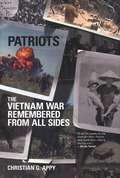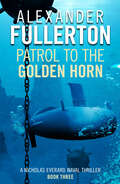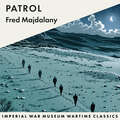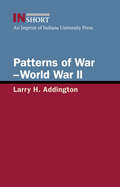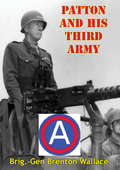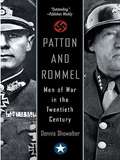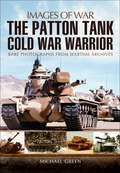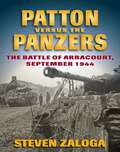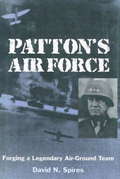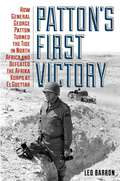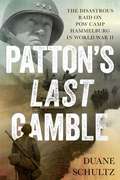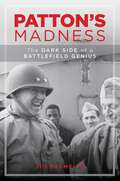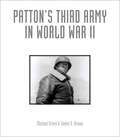- Table View
- List View
Patriots: The Vietnam War Remembered from All Sides
by Christian G. AppyHaving written two previous books about the Cold War, Appy here assembles recent perspectives on the Vietnam War from veterans, prisoners of war, peace activists, journalists, policymakers, generals, US and Vietnamese government officials, Vietnamese on both sides, those who were children then, and others. Annotation (c)2003 Book News, Inc., Portland, OR (booknews.com)
Patrol (Casemate Classic War Fiction #2)
by Philip MacDonaldThe novel that inspired John Ford&’s The Lost Patrol: A band of World War I soldiers fights to survive in the desert after their leader is shot and killed.There had been, here, eleven men. Now ten rode away. . . . In the Mesopotamian desert during the First World War, an unseen enemy guns down the leader of a British parol. The officer was the only one who knew their orders, and he did not told anyone else where they are located. Now the sergeant must lead his men through a hostile desert landscape full of invisible Arab snipers. One by one, they are being picked off, and the group of diverse men with different backgrounds must try to come together in order to survive. The decision-making process proves far from easy as tensions and prejudices from their former lives come to a head. The basis for films by Walter Summer and John Ford, this bestselling novel is a suspenseful tale of the Great War for readers of Robert Graves or Ford Madox Ford—or anyone who enjoys an action-packed war story. Author Philip MacDonald, who served in Mesopotamia with the British cavalry, went on to become one of the most popular writers of thrillers and detective fiction.
Patrol to the Golden Horn (Nicholas Everard Naval Thrillers)
by Alexander FullertonNicholas Everard is ready to run the gauntlet in his most dangerous mission yet…The menacing bulk of the German battlecruiser Goeben lurks in the Golden Horn of Constantinople. It is vital that she is destroyed, and the plan is to send an E-class submarine in through the Dardanelles to sink her unawares.But it has been two years since an Allied submarine passed through the narrow straits successfully, littered as they are with minefields, nets and depth charges dropped by the gunboats endlessly patrolling above.To send a crew in now would be a death sentence, but sparing the Goeben is unthinkable. Enter Nick Everard.An unputdownable story of the final days of WWI, perfect for fans of Douglas Reeman and Patrick O’Brian.Praise for Alexander Fullerton‘The most meticulously researched war novels that I have ever read' Len Deighton
Patrol to the Golden Horn (Nicholas Everard Naval Thrillers)
by Alexander FullertonNicholas Everard is ready to run the gauntlet in his most dangerous mission yet…The menacing bulk of the German battlecruiser Goeben lurks in the Golden Horn of Constantinople. It is vital that she is destroyed, and the plan is to send an E-class submarine in through the Dardanelles to sink her unawares.But it has been two years since an Allied submarine passed through the narrow straits successfully, littered as they are with minefields, nets and depth charges dropped by the gunboats endlessly patrolling above.To send a crew in now would be a death sentence, but sparing the Goeben is unthinkable. Enter Nick Everard.An unputdownable story of the final days of WWI, perfect for fans of Douglas Reeman and Patrick O’Brian.Praise for Alexander Fullerton‘The most meticulously researched war novels that I have ever read' Len Deighton
Patrol: Imperial War Museum Wartime Classics
by Fred Majdalany1943, the North African desert. Major Tim Sheldon, exhausted and battle weary, is tasked with carrying out a futile and unexpected patrol mission. Fred Majdalany's intimate, tense novel puts this so-called minor action centre stage, as over the course of the day and through the night of the patrol itself, Sheldon reminisces about his time as a soldier, his own future, and what it means to confront fear.Based on Fred Majdalany's own wartime experience with the Lancashire Fusiliers in North Africa, this new edition of a 1953 classic includes a contextual introduction from IWM which sheds new light on the true events that so inspired its author.'If poetry was the supreme literary form of the First World War then, as if in riposte, in the Second World War, the English novel came of age. This wonderful series is an exemplary reminder of that fact' WILLIAM BOYD'An absolute gem. The attention to detail, the rising tension and the utterly convincing characters... stunning' JAMES HOLLAND'When a man has been a soldier and seen action, he writes of war with true understanding, and with authority. When that man writes with wit, elegance and imagination, as Fred Majdalany does in Patrol, he produces a military masterpiece' ALAN MALLISON(P)2020 Headline Publishing Group Ltd
Patterns of Violence Behind the Lines in Europe’s Civil Wars (World Histories of Crime, Culture and Violence)
by Francisco J. Leira-Castiñeira John SakkasThis edited collection examines the violence experienced by non-combatants during the civil wars which took place in Europe in the first half of the twentieth century. The determinants of violence in civil wars are highly complex and variable. By focusing on both the victims and perpetrators of violence in eight European countries, including Russia, Ireland, France and Spain, the book explores what happened when differing groups within a polity clashed, and in which ways internal conflicts manifested themselves and permeated societies. Divided into two parts, the chapters firstly identify and analyse how rearguard violence was produced and exercised during the European civil wars, and secondly, they examine the violence perpetrated by, and against, women. Shedding light on the violence that was inflicted upon European civilians in the early- to mid-twentieth century, this book presents insights for historians of Europe, political scientists, and international relations scholars alike.
Patterns of War—World War II
by Larry H. AddingtonA brief survey of the evolution of warfare during World War II, by the author of America&’s War in Vietnam. Drawn from the second edition of Larry H. Addington&’s The Patterns of War Since the Eighteenth Century, this e-book short discusses the evolution of warfare during World War II. Addington highlights developments in strategies and tactics and logistics and weaponry, providing detailed analyses of important battles and campaigns. It is an excellent introduction for both students and the general reader.Praise for The Patterns of War Since the Eighteenth Century&“There is nothing else in print that tells so much so concisely about how war has been conducted since the days of Gen. George Washington.&” —Russell F. Weigley&“A superior synthesis. Well written, nicely organized, remarkably comprehensive, and laced with facts.&” —Military Affairs
Patton And His Third Army
by Colonel Brenton G. WallaceOl' Blood and Guts' head of liaison officers tells the story of the famous general as he saw him at the head of the Third Army during World War II."THE powerful Third Army with its famous leader, General George S. Patton, Jr., which in ten months roared through France, Belgium, Luxembourg, Germany, Czechoslovakia and Austria, crushing at every turn the German war machine which in 1940-42 was considered the most powerful army in the world, have now passed into history. Before the memory of the great days of these campaigns as well as the close association with this famous American fighter grow dim, it might be interesting to jot down the story of the events as they unfolded and a few personal impressions of our leader.This therefore is the story of The Third Army and its great commander."
Patton And Rommel
by Dennis ShowalterGeneral George S. Patton. His tongue was as sharp as the cavalry saber he once wielded, and his fury as explosive as the shells he'd ordered launched from his tank divisions. Despite his profane, posturing manner, and the sheer enthusiasm for conflict that made both his peers and the public uncomfortable, Patton's very presence commanded respect. Had his superiors given him free rein, the U.S. Army could have claimed victory in Berlin as early as November of 1944. General Erwin Rommel. His battlefield manner was authoritative, his courage proven in the trenches of World War I when he was awarded the Blue Max. He was a front line soldier who led by example from the turrets of his Panzers. Appointed to command Adolf Hitler's personal security detail, Rommel had nothing for contempt for the atrocities perpetrated by the Reich. His role in the Führer's assassination attempt led to his downfall. Except for a brief confrontation in North Africa, these two legendary titans never met in combat. Patton and Rommel is the first single-volume study to deal with the parallel lives of two generals who earned not only the loyalty and admiration of their own men, but the respect of their enemies, and the enmity of the leaders they swore to obey. From the origins of their military prowess, forged on the battlefields of World War I, to their rise through the ranks, to their inevitable clashes with political authority, military historian Dennis Showalter presents a riveting portrait of two men whose battle strategies changed the face of warfare and continue to be studied in military academies around the globe.
Patton Tanks: D-day To Victory (Images Of War Bks.)
by Michael GreenThe end of WW2 and the early Cold War years saw the need for a more powerful tank than the Sherman and Pershing tanks. The first Patton tanks (M46) were converted Pershings which saw service in Korea. As the Cold War intensified, the M47 with a more effective 90mm gun and turret went into mass production (9000 built) and countered the Soviet build up.The M48 entered service in 1953 and the M47s were sold off to allies whose armies were being rebuilt.The original M48 had serious deficiencies. Nevertheless over 12000 of numerous variants (MY8A1/A2/A2C) came into service. These were followed by the M48A3 which the Marines took to Vietnam.In the late 1950s the Americans overcame their aversion to diesel power and the M60 with its British designed 105mm gun came into service. By 1982 over 15000 units had been built in four basic models.Simultaneously 200 of the M48A5 with the 105mm gun went into service with the Army Reserve and National Guard and friendly foreign armies.To complicate matters, countries such as Israel made their own modifications to M48s which remained in service until the late 1990s.As this fascinating book reveals Pattons were made into specialist role vehicles, be they anti-aircraft, flame throwers, recovery, combat engineer.
Patton Versus the Panzers: The Battle of Arracourt, September 1944
by Steven ZalogaIn September 1944 Hitler ordered an attack on Gen. George Patton's Third Army, which was deep inside France making for the Rhine and threatening the German industrial heartland beyond. The ensuing battle near Arracourt--the U.S. Army's largest tank-versus-tank clash until the Bulge--went badly for the Germans, who committed their armor piecemeal and whose offensive was shattered in a series of intense, close-range tank duels with the Americans. Armor expert Steven Zaloga deftly reconstructs the battle and shows how American Sherman tanks bested superior German Panthers.
Patton and His Pistols (Stackpole Classics)
by Perry ParkeIntrigued by hints of &“the bigger man&” behind the war personality of Gen. George S. Patton, Jr., the Curator of History of the West Point Museum and a former &“Army wife&” studied and compared innumerable legends and stories about him. The resulting profile is the unvarnished Patton, as the public saw him and as his friends and soldiers knew him. Based solidly on contemporary sources, many of them never before tapped by historians, Patton&’s exploited in Mexico, in France in 1918, and during World War II, are strung together by kernels of truth often more startling than the fiction which has surrounded them. One of America&’s most famous and controversial generals is depicted through his attitude toward his famous hand guns and uniforms, and the manner in which he reacted to war and to peace.Four pistols are featured in the book, because four pistols were featured in his ife. Sixteen pages of pertinent illustrations, many published for the first time…including the only known photograph of Patton carrying two pistols…accompany the documented narrative. The pistol expert will find detailed appendixes on General Patton&’s favorite weapons and their accouterments.Patton and His Pistols is a book for everyone interested in Patton the leader and Patton the man.
Patton at the Battle of the Bulge
by Leo BarronDecember 1944. For the besieged American defenders of Bastogne, time was running out....Hitler's forces had pressed in on the small Belgian town in a desperate offensive designed to push back the Allies, starting the Battle of the Bulge. So far the U.S. soldiers had managed to repel waves of attackers and even a panzer onslaught. But as their ammunition dwindled, the weary paratroopers of the 101st Airborne could only hope for a miracle--a miracle in the form of General George S. Patton and his Third Army.More than a hundred miles away, Patton, ordered to race his men to Bastogne, was already putting in motion the most crucial charge of his career. Tapped to spearhead his counterstrike against the Wehrmacht was the 4th Armored Division, a bloodied but experienced unit that had fought and slogged its way across France. But blazing a trail into Belgium meant going up against some of the best infantry and tank units in the German Army. Failure to reach Bastogne in time could result in the overrunning of the 101st--a catastrophic defeat that could turn the tide of the war and secure victory for the Nazis.In Patton at the Battle of the Bulge, Army veteran and historian Leo Barron explores one of the most famous yet little told clashes of the war, a vitally important chapter in one of history's most legendary battles.
Patton at the Battle of the Bulge: How the General's Tanks Turned the Tide at Bastogne
by Leo BarronDecember 1944. For the besieged American defenders of Bastogne, time was running out....Hitler's forces had pressed in on the small Belgian town in a desperate offensive designed to push back the Allies, starting the Battle of the Bulge. So far the U.S. soldiers had managed to repel waves of attackers and even a panzer onslaught. But as their ammunition dwindled, the weary paratroopers of the 101st Airborne could only hope for a miracle--a miracle in the form of General George S. Patton and his Third Army.More than a hundred miles away, Patton, ordered to race his men to Bastogne, was already putting in motion the most crucial charge of his career. Tapped to spearhead his counterstrike against the Wehrmacht was the 4th Armored Division, a bloodied but experienced unit that had fought and slogged its way across France. But blazing a trail into Belgium meant going up against some of the best infantry and tank units in the German Army. Failure to reach Bastogne in time could result in the overrunning of the 101st--a catastrophic defeat that could turn the tide of the war and secure victory for the Nazis.In Patton at the Battle of the Bulge, Army veteran and historian Leo Barron explores one of the most famous yet little told clashes of the war, a vitally important chapter in one of history's most legendary battles.
Patton in Mexico: Lieutenant George S. Patton, the Hunt for Pancho Villa, and the Making of a General
by Michael Lee LanningHad Lieutenant George S. Patton not served on the southern border during the Mexican Expedition of 1916, there might never have been a General George S. Patton who took the world by storm as a bold and daring commander during World War II. Relying on Patton&’s detailed personal journals of his eight months in Mexico, Michael Lee Lanning describes the young officer&’s exploits during the hunt for Pancho Villa. As an aide to General John Pershing, Patton learned leadership and logistics from the man who would soon command American forces in World War I. Begging for a field command, he received it—and led the first motorized attack in U.S. military history and may or may not have killed two of Villa&’s lieutenants. The press ate it up, and Patton learned not only how much he loved attention, but how to promote himself.In Mexico are the roots of Patton the World War II general, and Lanning tells the story deftly, focusing on Patton the man as well Patton the commander, and always casting an eye forward to Patton&’s future career. This is how Patton became Patton.
Patton's Air Force
by David N. SpiresFrom the time the Third Army became operational on August 1, 1944, until the guns fell silent on May 8, 1945, Lt. Gen. George S. Patton's troops covered more ground and took more enemy prisoners than any other Allied army in northwest Europe. Brig. Gen. Otto P. Weyland's XIX Tactical Air Command (TAC) provided air support every step of the way. Their combined success is something of an anomaly; air-ground relationships are notoriously confrontational and plagued with inter-service competition. How did Patton and Weyland work together to achieve such astounding success? Drawing on exclusive access to official records, David N. Spires finds that this success was due to four key developments: the maturation of tactical aviation doctrine, effective organizational procedures, a technical revolution in equipment, and, above all, the presence of pragmatic men of goodwill who made the system work. He focuses on the highly effective personal relationship between Patton and Weyland -- men who respected, trusted, and fully relied on each other and their respective subordinates. This collaboration extended all the way down the chain of command: Patton's ground troops and Weyland's airmen trained together in England, and so by the time they entered combat, they operated together as a single unit. Contrary to conventional wisdom, air-ground relationships in the field can be cooperative rather than confrontational. Today's air and ground officers can continue to benefit from the amazing success of the Third Army and the XIX TAC.
Patton's First Victory: How General George Patton Turned the Tide in North Africa and Defeated the Afrika Korps at El Guettar
by Leo BarronAmerican troops invaded North Africa in November 1942, but did not face serious resistance until the following February, when they finally tangled with Rommel&’s Afrika Korps—and the Germans gave the inexperienced Americans a nasty drubbing at Kasserine Pass. After this disaster, Gen. George Patton took command and reinvigorated U.S. troops with tough training and new tactics. In late March, at El Guettar in Tunisia, Patton&’s men defeated the Germans. It was a morale-boosting victory—the first American success versus the Germans and the first of Patton&’s storied World War II career—and proved to the enemy, the British, and the Americans themselves that the U.S. Army could fight and win.
Patton's Last Gamble: The Disastrous Raid on POW Camp Hammelburg in World War II
by Duane SchultzIn March 1945, against the advice of his top subordinates, Gen. George Patton created a special task force to venture more than fifty miles behind enemy lines and liberate a POW camp near Hammelburg, Germany. The camp held some 1,500 American prisoners, including Patton&’s son-in-law. Hampered by ambushes and a lack of fuel and even maps, the raid was a disaster, one of the worst mistakes of Patton&’s legendary career. Out of some 300 men, only three dozen returned. Based on memoirs, diaries, combat reports, and interviews with survivors, Patton&’s Last Gamble vividly recounts a mission Gen. Omar Bradley later said &“began as a wild goose chase and ended in tragedy.&”
Patton's Madness: The Dark Side of a Battlefield Genius
by Jim SudmeierDwight Eisenhower called General George S. Patton &“mentally unbalanced&” and &“just like a time bomb,&” and indeed, the egotistical, mercurial, aggressive Patton is perhaps as well known for his questionable behavior and eccentric beliefs as for his daring battlefield exploits. In a brief but probing assessment of Patton&’s life based on strong research in primary sources and knowledge of psychology, Jim Sudmeier considers the mind of Patton: what made this military genius tick? To what extent was Patton&’s boldness and brilliance as a general, his willingness to welcome risk and danger, connected to his unstable personality? Sudmeier presents a myth-shattering reconsideration of one of military history&’s most famous commanders.
Patton's One-Minute Messages: Tactical Leadership Skills of Business Managers
by Charles ProvinceThis collection of George S. Patton's pithy one-liners shows how business managers can succeed by applying the combat-tested principles of one of America's most famous battlefield leaders. Also featured are the works of W. Edwards Deming and Walter A. Shewhart, two pioneers in quality control who have influenced management practice for over 50 years.
Patton's Panthers: The African-American 761st Tank Battalion In World War II
by Charles W. SasserOn the battlefields of World War II, the men of the African American 761st Tank Battalion under General Patton broke through enemy lines with the same courage with which they broke down the racist limitations set upon them by others—proving themselves as tough, reliable, and determined to fight as any tank unit in combat.Beginning in November 1944, the 761st Tank Battalion engaged the enemy for 183 straight days, spearheading many of General Patton's offensives at the Battle of the Bulge and in six European countries. No other unit fought for so long and so hard without respite. The 761st defeated more than 6,000 enemy soldiers, captured thirty towns, liberated Jews from concentration camps—and made history as the first African American armored unit to enter the war. This is the true story of the Black Panthers, who proudly lived up to their motto (Come Out Fighting) and paved the way for African Americans in the U.S. military—while battling against the skepticism and racism of the very people they fought for.
Patton's Payback: The Battle of El Guettar and General Patton's Rise to Glory
by Stephen L. MooreA stirring World War II combat story of how the legendary George Patton reinvigorated a defeated and demoralized army corps, and how his men claimed victory over Germany&’s most-feared general, Erwin Rommel &“Moore brings you to the battlefield and into the mind of a fearless military genius.&”—Brian Kilmeade, bestselling author of The President and the Freedom Fighter • &“Essential reading.&”—Kevin Maurer, #1 NYT bestselling coauthor of No Easy Day • &“[Moore] has a smooth prose style and a firm grasp of detail.&”—The Wall Street JournalIn March 1943, in their first fight with the Germans, American soldiers in North Africa were pushed back fifty miles by Rommel&’s Afrika Korps and nearly annihilated. Only the German decision not to pursue them allowed the Americans to maintain a foothold in the area. General Eisenhower, the supreme commander, knew he needed a new leader on the ground, one who could raise the severely damaged morale of his troops. He handed the job to a new man: Lieutenant General George Patton. Charismatic, irreverent, impulsive, and inspiring, Patton possessed a massive ego and the ambition to match. But he could motivate men to fight. He had just ten days to whip his dispirited troops into shape, then throw them into battle against the Wehrmacht&’s terrifying Panzers, the speedy and powerful German tanks that U.S. forces had never defeated. Patton, who believed he had fought as a Roman legionnaire in a previous life, relished the challenge to turn the tide of America&’s fledgling war against Hitler—and the chance to earn a fourth star.
Patton's Peers
by John A. English• Covers Canadian Harry Crerar, Briton Miles Dempsey, Frenchman Jean de Lattre de Tassigny, and the Americans Courtney Hodges, William Simpson, and Alexander Patch• History of the campaign for northwest Europe, including the race across France, the liberation of the channel ports, the battles of the Huertgen Forest and the Bulge, crossing the Rhine, the climactic battle for Germany, and more• Corrects the historical misperception that Patton contributed more to victory than other generals• Assesses commanders' individual performances• Impressively researched in primary and secondary sources• New interpretations and an entertaining narrative will appeal to both general readers and scholarsThrough the force of his personality and the headline-grabbing advance of his U.S. Third Army, Gen. George S. Patton has eclipsed the other six men who, like him, led field armies in the great Allied campaign to liberate northwest Europe in 1944-45. Certain to rank among the lassics of World War II history like Eisenhower's Lieutenants by Russell Weigley, Patton's Peers presents a masterful reassessment of the eleven-month struggle from D-Day to Germany's surrender, shedding long-overdue light on the contributions of these forgotten Allied field army commanders.Seasoned military historian John A. English unearths the vital roles played by these six generals. As the leader of an army of several hundred thousand troops, each had to plan operations days and eeks in advance, coordinate air support, assess intelligence, give orders to corps commanders, manage a staff of sometimes difficult subordinates, and deal with superiors like Eisenhower, Bradley, and Montgomery. Some performed less ably than the rest while others rivaled Patton in their achievements. All deserve to be lifted from Patton's shadow.
Patton's Prayer: A True Story of Courage, Faith, and Victory in World War II
by Alex KershawFrom Alex Kershaw, author of the New York Times bestseller Against All Odds, comes an epic story of courage, resilience, and faith during the Second World War General George Patton needed a miracle. In December 1944, the Allies found themselves stuck. Rain had plagued the troops daily since September, turning roads into rivers of muck, slowing trucks and tanks to a crawl. A thick ceiling of clouds had grounded American warplanes, allowing the Germans to reinforce. The sprint to Berlin had become a muddy, bloody stalemate, costing thousands of American lives. Patton seethed, desperate for some change, any change, in the weather. A devout Christian, he telephoned his head chaplain. &“Do you have a good prayer for the weather?&” he asked. The resulting prayer was soon printed and distributed to the 250,000 men under Patton&’s command. &“Pray when driving,&” the men were told. &“Pray when fighting. Pray alone. Pray with others. Pray by night and pray by day. Pray for the cessation of immoderate rains, for good weather for Battle. . . . Pray for victory. . . . Pray for Peace.&” Then came the Battle of the Bulge. Amid frigid temperatures and heavy snow, 200,000 German troops overwhelmed the meager American lines in Belgium&’s Ardennes Forest, massacring thousands of soldiers as the attack converged on a vital crossroads town called Bastogne. There, the 101st Airborne was dug in, but the enemy were lurking, hidden in the thick blanket of fog that seemed to never dissipate. A hundred miles of frozen roads to the south, Patton needed an answer to his prayer, fast, before it was too late.
Patton's Third Army in World War II
by Michael Green James D. BrownPatton was champing at the bit to lead the D-Day invasion, but Eisenhower placed him in command of a decoy unit, the First U.S. Army Group. Nearly seven weeks after D-Day, Patton finally got his chance to take Third Army into battle. He began a ten-month rampage across France, driving through Germany and into Nazi-occupied Czechoslovakia and Austria. Along the way Third Army forces entered the Battle of the Bulge, breaking the siege of Bastogne. It was a turning point in the war, and afterward the Third Army pushed eastward again. Patton’s Third Army in World War II covers Patton’s command of Third Army with a focus on the armor. It was a new style of fighting, avoiding entrenched infantry warfare by continuously pushing forward, and it appealed to Patton’s hard-charging personality. Archival photos along with frequent quotes complete the portrait of Patton as well as his men as they fight their way across the Third Reich.
